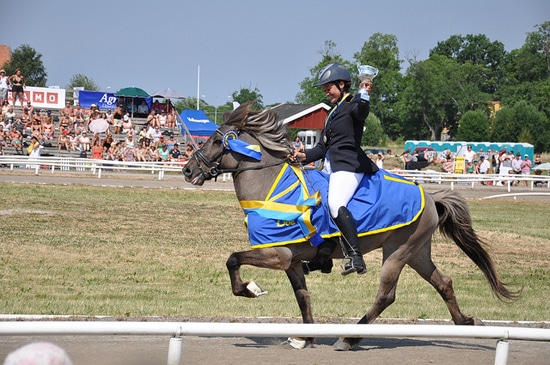Icelandic horses have two extra gaits. In addition to the gaits which all horses show (walk, trot, canter), Icelandic horses also have tölt and pace. In Iceland, the tölt is highly-valued because it is so comfortable to ride over long distances.
Tölt is referred to as the fourth gait. It has four beats with phases in which the horse has either one or two legs on the ground at all times. There is no floating phase in which no leg is touching the ground. This means the rider never experiences a jolt as the horse’s weight returns to the ground. Tölt can be ridden either very slow to very fast, called ‘racing-tölt’. In racing tölt, icelandic horses can reach speeds of up to 40 km/hr!
1. If you were riding at that speed how far could you go in 15 minutes?

The Icelandic horse Gæðingamót Fáks in 2009 performing the full-speed “flying pace”.
The fifth gait many icelandic horses have is the pace. Pace is a lateral gait with a floating phase. The pair of legs on each side of the horse hit the ground alternately and the floating phase is between these movements. Pace is ridden in a racing tempo over short stretches of a few hundred meters. Speeds of up to 50 km/hr can be reached!
2. If you were riding at 50 km/hr, how far could you go in 15 minutes?
Not surprisingly, there are timed events to find out the fastest horse. In the 250m Pace Race (P1), the horses begin at a standing start from a starting box. The horses are given 50m to begin pacing and must be pacing between the 50m mark and the 250m finish line. The World Record is 21.84 seconds. At this year’s World Championships the winning time was 21.97 seconds.
3. Calculate the time difference between the championship winning time and the world record. Give your answer in word form.
Care to watch a few races?
Icelandic horses are also the only breed of horses which has its own world championship. This year’s World Championships for Icelandic Horses took place in August in front of more than 13,000 people in Berlin, Germany and for the first time there were specific finals and medals for Young Riders at the championships.
Just like in other horse shows, there are different classes. In the Four Gait competition the riders show four gaits in five test sections, slow tölt, slow to medium speed trot, medium walk, slow to medium speed canter and fast tölt.
In the Five Gait competition, the riders show five gaits also in five test sections, slow to medium speed tölt, slow to medium speed trot, medium walk, slow to medium speed canter and racing pace.
Scoring

Each judge’s mark is determined by adding the scores given for each section together and dividing them by the number of sections in the test.
4. What is it that is being calculated here?
5. If a judge wanted to raise a 6.5 score one increment higher, what would be the next highest score she could give?
The winner in this year’s World Championship Four Gait Youth final received the following scores:
Don’t let commas between the numbers confuse you – in Europe commas are used where decimals are used in North America.
6. What does each row represent on this chart?
7. What does each column on the chart represent?
8. What was Johanna and her horse Merkur von Birkenlund’s final score for the Walk section of the competition?
9. After looking at the photographs and watching the videos, estimate the average height of an Icelandic horse.
1. If you were riding at that speed how far could you go in 15 minutes?
Answer: Step 1 – calculate what fraction of an hour 15 minutes is. 15/60 = 1/4. 15 minutes is 1/4 of an hour.
Step 2: 1/4 x 40km = 10km. You would travel 10km in 15 minutes.
2. If you were riding at 50 km/hr, how far could you go in 15 minutes?
Answer: Step 1: 15/60 = 1/4. 15 minutes is 1/4 of an hour.
Step 2: 1/4 x 50km = 12.5km. You would travel 12.5 km in 15 minutes.
3. Calculate the time difference between the championship winning time and the world record. Give your answer in word form.
Answer: 21.97 – 21.84 = .13. The time difference was thirteen hundredths of a second.
4. What is it that is being calculated here?
Answer: A judges average score for a rider’s test.
5. If a judge wanted to raise a 6.5 score one increment higher, what would be the next highest score she could give?
Answer: 7
6. What does each row represent on this chart?
Answer: The gait.
7. What does each column on the chart represent?
Answer: An individual judges scores.
8. What was Johanna and Merkur von Birkenlund’s score for the Walk section of the competition?
Answer: (7.0 + 7.5 + 8.0 + 8.5 + 7.5) ÷ 5 = 38.5 ÷ 5 = 7.7. Johanna and Merkur’s score for the Walk section of the competition was 7.7 points.
9. After looking at the photographs and watching the videos, estimate the average height of an Icelandic horse.
Answer: Icelandic horses average 13 to 14 hands in height. How close was your estimate?
Common Core:
4.OA.A.2 – Addition, subtraction, multiplication, and division word problems
4.MD.A.1 – Fractions of time units
4.MD.A.2 – Use the four operations to solve word problems involving distances, intervals of time
5.NBT.A.3 – Read, write, and compare decimals to thousandths.
5.NF.B.4 – Apply and extend previous understandings of multiplication to multiply a fraction or whole number by a fraction
5.NBT.B.7 – Add, subtract, multiply, and divide decimals to hundredths
Photos:
Icelandic Horse by Neil D’Cruze; CC BY 2.0
Gammur.jpg by Jónas R Jónsson; CC BY 3.0
Gæðingamót Fáks 2009 242.png by Dagur Brynjólfsson; CC BY-SA 3.0
DSC_0237 by Marcus Bergfeldt; CC BY 2.0









